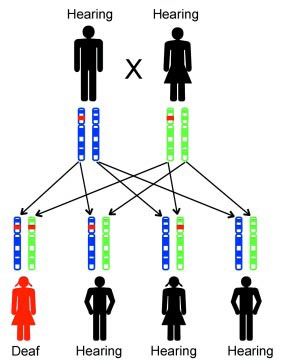
Children receive one copy of each chromosome from their mother (shown in green) and one copy from their father (shown in blue). In this image, a red band represents a recessive mutation in a gene on one copy of the father’s chromosomes and a second red band represents a recessive mutation in the same gene on one copy of the mother’s chromosomes. Each child has a 50% chance of receiving the copy with the recessive mutation from either parent. But, in the case of recessive mutations, both copies need to be altered for an individual to be affected. The chance of two events happening at the same time can be found by multiplying the chance of the two separate events together.
(chance of receiving mutation from father) x 1/2
(chance of receiving mutation from mother) x 1/2
= (chance of receiving two mutations) 1/4
Therefore, in each pregnancy, there is a 25% chance that the child will inherit both mutations and, on average, 1 out of 4 children will be have Usher syndrome.







